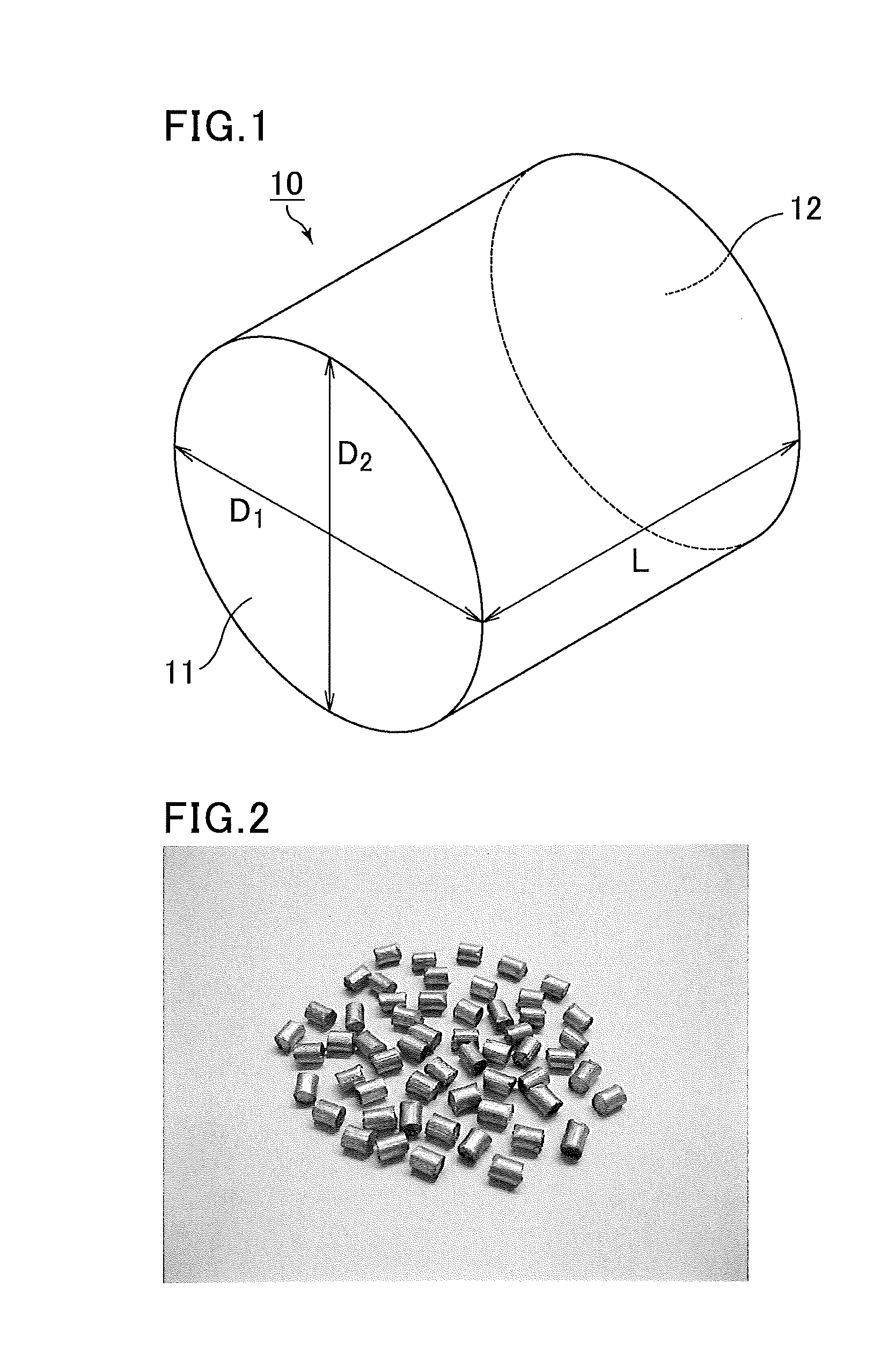Masterbatch, masterbatch group, production method for masterbatch, and synthetic resin molded article
a technology of masterbatch and synthetic resin, which is applied in the field of masterbatch, masterbatch group, and production method of masterbatch, can solve the problems of affecting the strength or appearance of the synthetic resin molded article, difficult to completely remove the solvent by this method, and the use of aluminum powder by itself is associated with a risk of dust explosion, etc., to achieve high pellet strength, improve the effect of strength or appearance, and reduce the amount of aluminum particles
- Summary
- Abstract
- Description
- Claims
- Application Information
AI Technical Summary
Benefits of technology
Problems solved by technology
Method used
Image
Examples
example 1
[0163]A masterbatch according to Example 1 was produced by the following procedure.
(a) Aluminum Paste Preparing Step
[0164]An aluminum paste (product name “Silveeds M100-BP” available from Asahi Kasei Chemicals Corporation) containing aluminum particles (average particle size: 10 μm, average thickness: 0.2 μm, shape: coin shape) and a polyethylene glycol at a weight ratio (aluminum particles:polyethylene glycol) of 90:10 was provided.
[0165]The intermediate pyrolysis temperature of the aluminum paste in a nitrogen atmosphere was 270° C. or higher.
(b) Mixing Step
[0166]To a container rotary-type mixer (model name “Tumbler ST-50E” available from Kawata MFG Co., Ltd.) were added 77.8% by weight of the aluminum paste, 19.9% by weight of polyethylene resin (melt flow rate of 22 g / 10 min (test temperature: 190° C., nominal load: 2.16 kg), product name “Novatec LJ803” available from Japan Polyethylene Corporation), 1.0% by weight of maleic acid-modified wax (melt flow rate of 9680 g / 10 min (t...
example 2 to example 7
[0170]Masterbatches according to Example 2 to Example 7 were produced in the same manner as in Example 1 except that the masterbatch composition was changed as shown in Table 1.
[0171]The numbers in the composition shown in Table 1 represent the percentage by weight.
[0172]In Table 1, the acrylic melt tension improver B is a high-molecular-weight acrylic polymer (product name “Metablen P530” available from Mitsubishi Rayon Co., Ltd.); the polypropylene resin is polypropylene (product name “H-700” available from Prime Polymer Co., Ltd) having a melt flow rate of 8.0 g / 10 min (test temperature: 230° C., nominal load: 2.16 kg) and a melt tension at 190° C. of 18.6 mN; and the high melt tension polyethylene is polyethylene (product name “HI-ZEX 6200BPU” available from Prime Polymer Co., Ltd) having a melt flow rate of 0.4 g / 10 min (test temperature: 190° C., nominal load: 2.16 kg) and melt tension at 190° C. of 88 mN.
example 8
[0173]A masterbatch according to Example 8 was produced by changing the aluminum paste to be prepared in the aluminum paste preparing step (a) in Example 1 as follows.
[0174]An aluminum paste containing acrylic resin-coated surface-coated aluminum particles (product name “PCF7640” available from Toyo Aluminum K.K., average particle size: 18 μm, average thickness: 0.4 μm) and a polyethylene glycol at a weight ratio (aluminum particles:polyethylene glycol) of 90:10 was prepared.
PUM
| Property | Measurement | Unit |
|---|---|---|
| melt flow rate | aaaaa | aaaaa |
| melt viscosity | aaaaa | aaaaa |
| melt flow rate | aaaaa | aaaaa |
Abstract
Description
Claims
Application Information
 Login to View More
Login to View More - R&D
- Intellectual Property
- Life Sciences
- Materials
- Tech Scout
- Unparalleled Data Quality
- Higher Quality Content
- 60% Fewer Hallucinations
Browse by: Latest US Patents, China's latest patents, Technical Efficacy Thesaurus, Application Domain, Technology Topic, Popular Technical Reports.
© 2025 PatSnap. All rights reserved.Legal|Privacy policy|Modern Slavery Act Transparency Statement|Sitemap|About US| Contact US: help@patsnap.com



